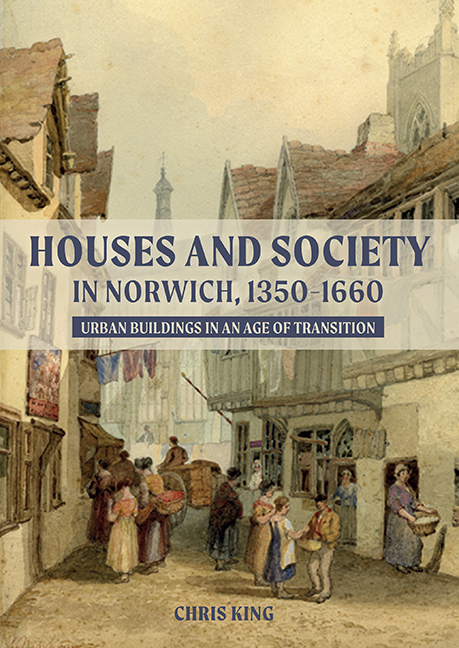Book contents
- Frontmatter
- Dedication
- Contents
- List of plates and figures
- List of tables
- Acknowledgements
- List of Abbreviations
- 1 Urban rebuildings, urban transitions
- 2 Norwich, 1350–1660: continuity and change in an English provincial city
- 3 Medieval merchants’ houses, c.1350–1540
- 4 Early modern merchants’ houses, c.1540–1660
- 5 The urban elite: domestic space, social identity and civic authority
- 6 Medieval houses and the urban ‘great rebuilding’
- 7 Houses of the ‘middling sort’: buildings and the use of space
- 8 Housing the urban poor and immigrant communities
- Conclusions
- Glossary
- Bibliography
- Index
- Plate Section
8 - Housing the urban poor and immigrant communities
Published online by Cambridge University Press: 23 October 2020
- Frontmatter
- Dedication
- Contents
- List of plates and figures
- List of tables
- Acknowledgements
- List of Abbreviations
- 1 Urban rebuildings, urban transitions
- 2 Norwich, 1350–1660: continuity and change in an English provincial city
- 3 Medieval merchants’ houses, c.1350–1540
- 4 Early modern merchants’ houses, c.1540–1660
- 5 The urban elite: domestic space, social identity and civic authority
- 6 Medieval houses and the urban ‘great rebuilding’
- 7 Houses of the ‘middling sort’: buildings and the use of space
- 8 Housing the urban poor and immigrant communities
- Conclusions
- Glossary
- Bibliography
- Index
- Plate Section
Summary
Poverty and migration in the early modern city
THE preceding chapters have focused on the architectural, excavated and documentary evidence for urban houses across the medieval and early modern periods with a focus on the larger surviving examples of well-built houses with several rooms on each floor. These houses were in most cases lived in by the householders, artisans and tradespeople who broadly constituted the ‘middling sort’ in urban society. The following chapter turns to consider the dwellings of the poorer inhabitants of the early modern city, by examining the archaeological evidence for small-scale houses on urban tenements in the northern and western districts, alongside the architectural evidence for surviving smaller houses, most commonly of single-cell plan with two or three storeys. It is important to stress, as has already been highlighted, that these broad distinctions in house size do not exactly or easily map onto clear status divisions in the urban population. Several of the single-cell houses in the city were located on the principal streets in the central parishes and are comparatively large and well-built; these are likely to have been the homes of relatively prosperous townspeople who may well have been independent artisans or traders and no doubt considered themselves to belong to the middling ranks of society. Other examples of smaller cottages are located in side-alleys and rear yards in the central districts, and in greater numbers in the more outlying parishes, and these are more obvious candidates for houses built for and occupied by more humble urban households. The same caveat is true of all of the excavated sites which have been introduced in earlier chapters, the majority of which have occurred, by reason of the progress of modern urban redevelopment, in what would have been more marginal zones within the early modern city. At the large-scale urban tenement excavations of Alms Lane and Oak Street in ‘Over the Water’, for example, there is clear evidence that houses facing the principal streets with two, three or more rooms per floor existed cheek by jowl with smaller houses.
- Type
- Chapter
- Information
- Houses and Society in Norwich, 1350–1660Urban Buildings in an Age of Transition, pp. 243 - 278Publisher: Boydell & BrewerPrint publication year: 2020



